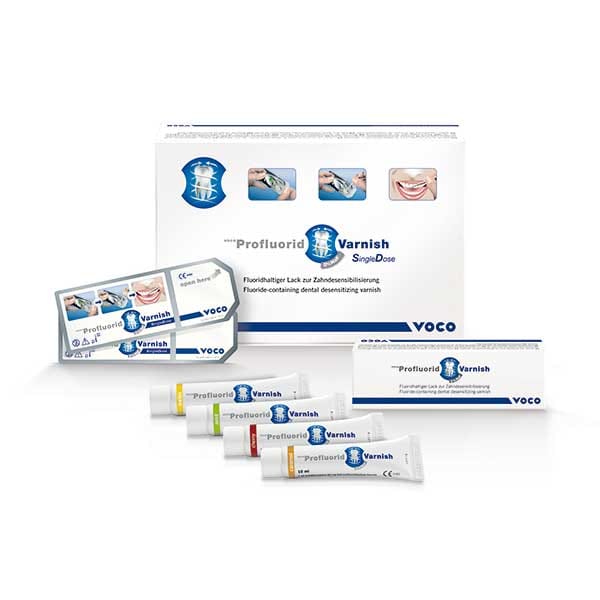Fluoride Varnish
Enhanced thin flow and single-dose delivery optimize the efficacy of Profluorid.
Profluorid with xylitol is VOCO America’s 5% sodium fluoride varnish in a new, nonmessy, single- dose delivery system. Fluoride varnish has been found effective in reversing active pit-and-fissure lesions in primary denition1 and is recommended as the topical fluoride of choice for children ages 6 to 12 years.2 According to VOCO, Profluorid’s enhanced thin flow characteristics allow it to reach areas sometimes missed by traditional varnishes, has immediate fluoride release that relieves hypersensitivity, effectively lines caries under amalgam restorations, and seals dentinal tubules for caries preparation or on sensitive root surfaces.
The melon-flavored varnish contains no saccharin, aspartame, or gluten and has no unpleasant aftertaste.
Moist Field Work
The manufacturer states that Profluorid adheres well to moist surfaces. When the 11 hygienists who participated in the evaluation were asked about ability to work in a moist field, 6 rated it as excellent, 4 rated it as very good, and 1 rated it as fair. One hygienist “loved it,” another reported “clumping,” and a third said it “didn’t clump on the brush in the presence of saliva.” One evaluator was “surprised how well it worked in a moist field,” 1 called moist field work “a big plus,” and another said it “didn’t thicken with moisture.” One hygienist said, “Wonderful. It stayed on the tooth at initial placement and then seemed to slough off the tongue and other soft tissues it touched.”
Ease of Application (Viscosity)
Ease of application was rated as excellent by 6 evaluators, as very good by 2, and as fair by 3. Comments ranged from “didn’t spread smoothly” and “too thick to flow easily” to “exceptionally easy…could have been a little thicker” and “very smooth, nonclumping, and didn’t stick to the brush.” One evaluator called the film “thin” and said it “went on easily.” Another evaluator said, “It was too thick and I couldn’t paint a visible thin coat. I wasn’t sure if I coated surfaces evenly.” The hygienist who called film thickness “nice and even” also called the brush “kind of awkward.” One hygienist called application “very easy…no clumping when going from one area to another,” and another found it “easy to use, but I had a little trouble getting on the lower anterior linguals.”
Viscosity was rated as excellent by 4 evaluators, as very good by 4, as good by 1, and as fair by 2. One hygienist “would like it to be slightly more liquid,” another reported “nice flow,” and a third called it “sticky for a while after application…didn’t spread easily.” The hygienist who described the consistency as “Vasoline-like” said it “stayed on the teeth during application and was easy to spread.” One hygienist “either saw clumps or didn’t see anything” and another said, “Coating was even…no need to really mix.”
Setting Time and Clear Curing
Profluorid is formulated to set in only seconds after contact with saliva and to cure without yellow discoloration. Setting time—rated as excellent by 4 evaluators, as very good by 5, as good by 1, and as poor by 1—was described as “quick,” and “awesome.” One hygienist said, “By the time I was on to the next quadrant, the first teeth were set and protected.” Ability to cure clear—rated as excellent by 6 evaluators, as very good by 4, and as fair by 1—was described as “fantastic,” “great and clear,” and “clear-whitish.” One hygienist said it “seemed a bit stark-white when applied but dried clear after a few seconds” and another called it “great…could be compared to [another varnish]” and “it stayed clear/not visible.”
Overall Satisfaction
Eight evaluators said they would definitely or probably recommend Profluorid to colleagues. Overall satisfaction was rated as excellent by 3 evaluators, as very good by 5, and as fair by 3.
References
1. Autio-Gold JT, Courts F. Assessing the effect of fluoride varnish on early enamel carious lesions in the primary dentition. J Am Dent Assoc. 2001;132:1247-1253.
2. Miller EK, Vann WF Jr. The use of fluoride varnish in children: a critical review with treatment recommendations. J Clin Pediatr Dent. 2008;32:259-264.






